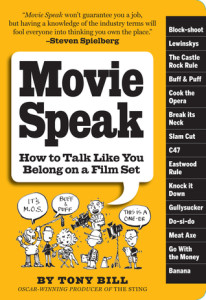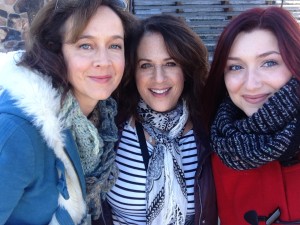By Marci Liroff
FADE IN: The A.D. squawks, “OK, this is the Martini! You need to walk in on a banana and clear the frame. Make sure you cheat toward the camera. Then I need first team back to one.” What crazy talk is this? In case you don’t know it, you are on a tv or movie set. Many of these terms are throwbacks to another era and have survived many generations of filmmakers. If you don’t know them you’re going to feel like you’ve dropped into another country and don’t speak the language. The lingo can be somewhat daunting if you don’t have a glossary handy. As always, I’m here to help.
After my last article referenced filming plenty of “heads and tails” when filming an audition, I thought it’s time to write an article detailing the language that goes on in the audition room and on-set. Kudos to my friend, director/producer/actor Tony Bill for his amazing book “Movie Speak – How to Talk Like You belong on a Film Set”. This book not only has an informative glossary, it gives the etymology of the word or expression in the film world along with stories from his years of being in the biz. Truly priceless.
Here are some of my favorite technical words and expressions.
The Abby Singer or “The Abby” named after the famous production manager who, as an A.D., realized that a few extra shots could be squeezed out of the busy shooting schedule if the crew began packing up and moving to the next location before a company move took place. This saved the production both time and money. This is typically the second to last shot of the day. It usually brings a quiet happy dance by much of the crew.
The Martini – the last shot of the day – meaning “the last shot is in the glass”!
The Jonesy – a new and bittersweet term on sets. This is the first shot of the day and honors assistant camerawoman Sarah Jones who lost her life on the set of the film Midnight Rider.
A.D. Assistant director. The A.D. runs the set. Next to the director, possibly the busiest person on the set. If you have a question, it might be better to go to the 2nd A.D. because the 1st A.D. is crazy busy.
P.A. – production assistant. It is probably the lowest on the food chain of the filmmaking community. This is one of the hardest jobs on the set as you will be responsible to deliver the exact coffee order to delivering meals to running lines with actors. You can also be the “eyes and ears” on-set and experience everything. Are you just starting out? This might be perfect your job. You will barely get paid but what you’ll see and learn is utterly priceless.
Room tone – is the “silence” recorded at a location or space when no dialogue is spoken. Every location has a distinct presence created by the position of the microphone in relation to the space boundaries. You are meant to stand still and not make a sound. Make sure your phone is turned off. Don’t be “that guy”.
M.O.S. – without sound. When the scene is shot without sound.
A.D.R./looping – Automated Dialogue Replacement, also called looping. During the editing process the actor is called back to re-record their voice. In a sound studio the scene is played back for the actor who re-records their lines sometimes due to outside sound such as an airplane overhead or to get a better performance. Sometimes entire performances are looped – Andie MacDowall’s performance in Tarzan was looped entirely by Glenn Close.
Banana – when walking through a scene you’ll do a slight curve, rather than a straight path, like a banana. You can do a right banana or a left banana. It helps the camera department to get the shot they need – rather than re-setting the shot and repositioning the camera. A “cashew” is a shorter banana.
Blocking – this is when the actors are on the actual shooting set and their movements are set up. The actors run the scene along with all their movements (from walking across the room, to picking up and drinking a cup of coffee). The director, A.D., D.P., lighting crew and script supervisor observe the blocking process so they’ll know where they need to put their equipment and how to light the scene. You’ll notice the camera crew throwing down little “bean bags” as markers whenever you move to different locations in the room. You also might find some directors block your audition scene. This is another reason why you need to be totally off-book when you arrive on-set or for your audition as you’ll be adding another layer of tasks to remember in a specific order. If you don’t know your lines perfectly, this next step will vex you. You need to do these movements exactly the same in each take for continuity.
Video village – this didn’t even exist 20 years ago. The encampment on the set, around the video monitor(s) so that all can view the action on set – and not actually be on the set. Several director chairs are set up in a silent pecking order -sometimes it’s in a covered tent. Here you can find the producers, writer, director, D.P., executives and any visiting guests. You don’t belong here unless you’re asked. Only the top tier of actors are welcome.
First team – you’ll hear the A.D. calling for “first team” when all the lighting is done and they’re ready to shoot. That’s you if you’re one of the actors (and not background/extras). Second team are the stand-ins and doubles.
Four-banger – a large trailer with four dressing rooms. You might be very excited to arrive on set and hear that you have a dressing room until you reach your single – which is coffin-like! There are also double and triple bangers and so on.
Gaffer – an electrician who is responsible for the execution, and sometimes the design, of the lighting plan.
Grip – the person who sets up the rigging for the lights and camera equipment.
Per Diem – Latin for “per day” or “for each day” – this is the money you get while shooting on location to pay for expenses (excluding housing and travel expenses). The various unions have minimum rates for per diem and can be found on their websites.
Sides – Sides are a few scenes from the script – usually used at the audition. Once you have the job and are on the set, the A.D. will give you your sides for the day – usually shrunken down to comfortably fit in your pocket. I’m still shocked when actors I’m coaching send me sides and call them the script.
Turnaround – The off-time hours guaranteed to actors and crewmembers between shooting days. A minimum time is guaranteed by the various union agreements. Many crewmembers aren’t guaranteed enough time to wrap, drive home after a long day of shooting, get the sleep they need, and get back to set the next day. See the famous D.P. Haskell Wexler’s important documentary, “Who Needs Sleep” for more info on the excessive work hours and the tragic results.
“Turnaround” also refers to the camera crew when they reset their cameras to shoot the other side of the conversation and turnaround to the other actor.
Stage left/right – In theater, stage left and right, at least in British and North American theatre, refer to the actor’s left and right when facing the audience.
Up-stage/Down-stage – the rear of the stage is considered up-stage. The front of the stage, nearest the audience, is down-stage.
Camera left/right – this is from the perspective of the camera. If you’re the actor and facing the camera, it’ll be your opposite view – looking at the camera, camera left will be YOUR right.
C-47 – One legend has it that an accountant, tired (or afraid) of explaining the purchase of a large quantity of clothespins, called them C-47s on the purchase order. Another story is that since they are often tossed from one crewmember to another, they were named after the WWII military version of the DC-3.
10-1 – the A.D.s usually use this term instead of saying the cast or crewmember is in the bathroom.
Honeywagon – Sounds kind of sexy. It’s not. It’s the bathroom.
Cowboy – this is a camera term from the days of westerns. The camera will frame “holstered guns-up level”, or waste/hips up. “Tight cowboy” would be above guns.
Sticks – the tripod
Lunch – It’s the meal served half-way through the shooting day. This one seems self-explanatory but on a film set you could have lunch at 3 in the morning – it’s still called lunch.
Magic hour/Golden hour – This is the D.P.’s delight. It is a period shortly after sunrise or before sunset during which daylight is redder and softer compared to when the Sun is higher in the sky. It’s been told that Terrence Malick shot Days of Heaven entirely during magic hour.
Golden time – when a crew is working past 16 hours. Everybody is exhausted, pissed off, and earning triple time!
Groucho – When an actor needs to crouch a bit as you approach the camera because they can’t tilt up. You can also do a “banana Groucho”
Pay or play – referring to an actor/director/writer getting paid whether the project is made or not. You either get paid or you’ll be “playing/acting” in the project. It’s the best kind of deal you can make.
Walk into frame – the frame is what the camera sees. You might be asked by a director on-set or in the audition room to walk into frame and hit your mark.
Cheat toward the camera – when you are having a conversation with someone you naturally face them. Sometimes when filming or auditioning, we’ll ask you to slightly turn more toward the camera so that we can see your expressions – hence “cheating” toward the camera.
Kill the baby! – I know filmmaking can be relentless but nobody is actually killing a child. This is when they turn off the baby Fresnel light.
Flying in – not actually flying like in a plane. When a request is made from a department head for a piece of equipment or a prop, the person who is retrieving it usually announces it’s “flying in” to the crew.
“We’re on the wrong set!” – No, you’re not actually on the wrong set – it’s what the A.D. says to signify a company move to the next set or location.
“Watch your back/Hot Points!” – you’ll hear the crew yelling this as they move equipment. Invariably, there’s always an intense discussion going on between the filmmakers directly in the path of the crew. This is their nice way of telling you to move your ass!
Hot set – A film set in which furniture, props (and sometimes food) are positioned for an imminent shoot – so labeled to prevent those items from being moved and thus compromising continuity in the finished product. You never want to mess with anything on a set, nor should you sit on the furniture unless you’re in the middle of the scene and told to do so.
Last looks – just before they start shooting the A.D. calls “last looks” so that the hair/make-up/prop people can make sure that the actors and the set looks exactly as it should before the camera rolls.
Back to one – if you think of your beginning position in a scene as one, that’s where you need to go back to when they call cut and start the scene again.
Checking the gate – no, they’re not going outside to see if the gate is open. The gate is a slot in the camera through which the film passes. On the completion of the filming of every scene, the A.D. orders that the gate be checked for any impurities such as lint or hair. If it’s not clear, images are spoiled and everything taken on that reel will have to be re-shot. These days so many productions aren’t using actual film and shoot digitally so you don’t hear it as often.
“What’s your 20?” – Usually spoken by crewmembers over their walkies (walkie-talkie) but is a corrupted phrase from the original “10-20” used by U.S. law enforcement to verbally encode their radio transmissions so that non-police listeners would not easily discover police operations.
Big eyes – when the AC (assistant cameraman) is focusing for a CU (close-up), he will usually ask the actor for “big eyes” and you want to do exactly that, without blinking or looking away, until focus is set.
What terms or expressions have you heard that you can share?
Make sure to check out my new online course “How To Audition For Film and Television: Audition Bootcamp”. You can view it on your laptop or your mobile device and your subscription gives you lifetime viewing privileges for this course. I’ll be adding lectures throughout the year.
Like this article? Help spread the word!
Click below to tweet!






Recent Comments